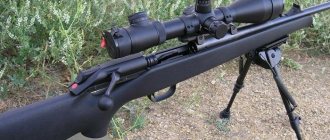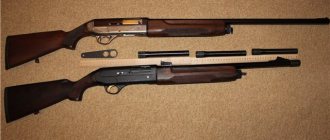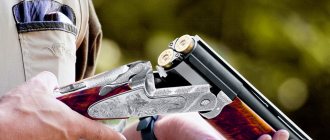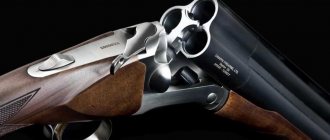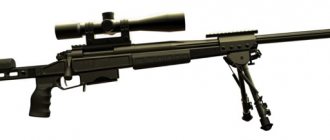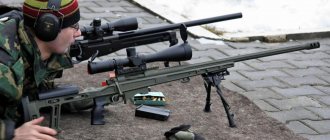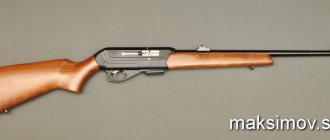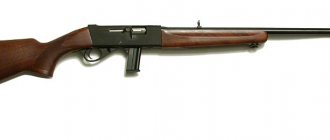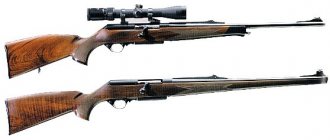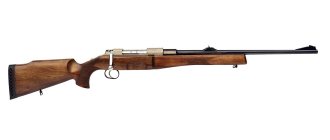Options
I believe that you no longer have any doubt that the Blaser R8, based on the totality of its functions and characteristics, is the best hunting rifle on the market.
You just open the box and take it out. The only thing that needs to be solved before this is a significant problem - choosing a configuration. And this is really a problem. The fact is that the R8 is offered in 44 calibers. I repeat: 44 calibers, from .204 Ruger to .338 Lapua Magnum - including .500 Jeffery, .300 RUM and others. Blaser R8 Professional Success with Jagdmatch match barrel in .308 Win - the most versatile starter pack
All this splendor is divided into seven groups according to the size of the case bottom, which allows you to determine when choosing which calibers can be used without the need to change the bolt cylinder. The bolt cylinder can be changed in a couple of seconds on the knee, and all the parts of the bolt, including the firing pin with the spring, do not fall out on the ground - very convenient when doing this in nature. You just need to purchase it first and carry it along with a replaceable barrel and magazine insert. When choosing the caliber of an additional barrel, it is sometimes possible to save money due to the same size of the cartridge case bottom; for example, if you are wondering whether to choose a 9.3x62 caliber barrel or .375 H&H to complement your existing .30-06 barrel, then when choosing a “nine” it is enough to buy only one barrel - but for the “Holland-Holland” you will need more and a new cylinder and a new magazine insert. Oh, by the way: 44-caliber barrels are also offered in different versions in length, diameter and external shape: round, octagonal, with longitudinal flutes, with or without threads on the muzzle. Note that the configuration of the barrel plays a role when choosing a stock. And the boxes here can be wooden, polymer or laminate. Wooden ones in the standard configuration consist of two parts - a forend and a butt, attached to the supporting chassis. There is also a solid wood Success stock with a thumb hole in the stock.
With a slight movement of your finger, the detachable magazine (above) turns into a non-detachable one
Blaser offers a laminate stock from GRS in combination with a match barrel as a sporting rifle. Polymer stocks are the Professional series, which includes the classic stock and Professional Success stocks in different designs, with leather inserts and carbon fiber. So, Blaser stocks are offered with different groove widths for the barrel: for 17 mm and for 19 mm. A match barrel with a muzzle diameter of 22 mm can be installed in a 19 mm stock, but will not fit in a 17 mm stock. In this case, a barrel with a diameter of 19 mm at the muzzle ends in a 17 mm stock, but with less clearance than in a 19 mm stock. Accordingly, if there are plans for different barrels with different diameters, then it makes sense to think in advance whether the stock will fit the barrel. Additionally, stocks for the Blaser R8 are offered on the market from different manufacturers and in different designs - and their number is increasing. Even in Ukraine it is planned to produce chassis-type stocks from the Ukrainian brand Automatic. It should be noted that the configuration options when ordering a new carbine are still limited. All options are thought out and verified based on many years of experience, and if you are not inclined to experiments and DIY, then it is wise to use a ready-made solution. If you have your own idea of beauty, then the modularity and range of calibers and barrels of the Blaser R8 provide a wide field for imagination. And here the Professional box comes into the arena again.
Match performance. Blaser R8 Professional Success carbine
Featuring a heavy fluted barrel, the Blaser R8 Professional Success is a top-notch precision rifle at an above-average price for its class of weapon. When shooting with 6.5x47 Lapua cartridges, this repeating rifle, produced in the city of Isny, showed good results even when shooting at long distances.
Most readers firmly associate the Blaser R8 bolt-action model with a hunting carbine. However, the R8 rifle, like the R93 that preceded it, is also manufactured by Blaser in a precision design. The editors of DWJ magazine were provided with a Blaser R8 Professional Success model with a heavy hunting match barrel with flutes chambered for the 6.5×47 Lapua cartridge.
A characteristic feature of the Blaser R8 Professional Success model is a plastic stock with a through hole for the thumb and leather inserts.
DWJ magazine has repeatedly published articles on the design of the Blaser R8 rifle. In this regard, the author will only briefly dwell on the description of the bolt group. Its basis is a light alloy chassis, to which the bolt, barrel, as well as the trigger and magazine unit are attached. The classic receiver is missing. The match barrel is made by Blaser using the cold forging method and has a diameter of 22 mm at the muzzle. In the breech cylindrical part of the barrel, at the locations of the chamber and radial locking with collets, there are two threaded pipes. Two corresponding holes are made in the chassis, leading to lock nuts located in the stock. The cylindrical breech of the barrel is placed in the “bed” of the chassis and fixed in it with the help of a steel recoil stop, which fits into the reciprocal groove of the barrel.
The sample weapon provided to the editors of DWJ magazine for test firing had a heavy match barrel with flutes chambered for the 6.5x47 Lapua cartridge. The diameter of the barrel at the muzzle was 22 mm.
| Manufacturer | Blaser Jagdwaffen GmbH www.blaser.de |
| Model | Blaser R8 Professional Success |
| Weapon type | Collet-type bolt-action repeating rifle |
| Cartridge | 6.5×47 Lapua |
| Magazine capacity | 4 rounds |
| Barrel length | 600 mm (23.622″) |
| Rifling pitch | 216 mm (8.5") |
| Aim | There is no open sight, there is a saddle bracket |
| Fuse | Manually pumping the mainspring |
| Weapon length | 1104 mm |
| Weapon weight | 3740 g (with empty magazine) |
| Materials used | Steel/plastic |
| Butt | Plastic |
The shutter moves along two guide chassis. The magazine and precision trigger form a single unit. Thus, the magazine can only be removed together with the trigger mechanism, which serves as an additional security measure and prevents unauthorized use of the weapon. The heart of the R8 rifle is a collet-type bolt that locks directly onto the barrel. The movement of the shutter only in the longitudinal direction provides an extremely high rate of fire.
Since its founding, Blaser has focused primarily on safety issues when using the weapons it produces. Therefore, even on the R93 rifle, which was the predecessor of the R8 model, a manual mainspring supercharger was installed.
Good stock design
In the standard version, the Blaser R8 rifle has a buttstock consisting of two parts. However, the Blaser R8 Professional Success model has a monolithic plastic one. The grip areas on the pistol neck and fore-end have leather inserts. The most characteristic feature of the Professional Success stock is its shape with a through hole for the thumb and an almost vertical pistol neck. This successful ergonomic shape of the stock in almost all settings ensures minimal load on the shooter’s hand and forearm.
What requires some getting used to is that when shooting, the thumb must first be inserted into the through hole, which, however, is quite large. After some training, this manipulation does not require additional time. The rear of the stock ends with a black rubber butt cap. Swivels are located on the end side of the forend and at the bottom of the rear part of the butt.
During the test firing, the rifle sample, which was made available to the editors of DWJ magazine and had impeccable workmanship, behaved impeccably in all respects, as befits a premium class weapon.
Made for precision shooting
View of the open bolt action of the Blaser R8 rifle. The shutter moves along two guides. Locking is carried out using collets.
The Minox ZP 5 5-25×56 model belongs to the classic optical sights used for tactical purposes. In the middle part its diameter is 34 mm. The sight is equipped with horizontal and vertical adjustments, parallax adjustment, and an illuminated reticle.
The rifle provided to the editors of DWJ magazine had a Minox optical sight, designed for tactical use and mounted using a reliable Blaser saddle bracket. It was a Minox ZP 5 5-25×56 model with an illuminated MR5 reticle located in the focal plane of the lens. The shock resistance, sealing and temperature loads of Minox's ZP line of sight bodies meet the standards of military products. The body of the Minox ZP 5 5-25×56 sight is made of aluminum alloy and has a diameter of 34 mm in the middle part. The eye relief is quite sufficient and is 90 mm. The visual acuity adjustment unit is made of light alloy and is adjusted using a ring. One of the three drums is designed for parallax adjustment ranging from 50 m to infinity. A device for adjusting the brightness range of the reticle illumination, which has 11 levels, is also located here. The values of adjustment parameters in the horizontal and vertical planes, marked on the adjustment drums, are clearly readable, including when the shooter is ready to open fire. The Minox ZP 5 5-25×56 sight impresses with its impeccable image quality with good sharpness even at the edges of the lenses, as well as the precision of the reticle adjustment, which is extremely necessary for tactical optical sights.
Cartridges for the Blaser R8 Professional Success rifle
The emergence of class F shooting disciplines at the very end of the 20th century, which quickly gained popularity throughout the world, led to the development of new cartridges for long-range shooting. Quite quickly, it became clear to class F shooters that 6.5 mm cartridges with a bullet with a diameter of 6.71 mm (.264″) were a good basis for creating new ammunition. The latter were developed on the basis of non-serial production cartridges with a bullet with a diameter of 6.71 mm (.264″). All of these non-standardized cartridges had case geometry proven in benchrest competitions: they were short with large diameters and a steep case angle. The most popular was the 6.5-284 cartridge, developed and put into mass production by Norma. The wear of match barrels is most affected by the small pitch of the rifling and the use of long bullets with high initial velocities. As a result, some match barrels fail and must be replaced after 2500–3000 shots.
An indispensable attribute of the R8 line of bolt-action rifles, like the previous R93 model line, is a manual mainspring supercharger. Its position in the rearmost position indicates that the weapon is not cocked (pictured on the left). When the Blaser R8 rifle is cocked, a red square mark is clearly visible under the manual mainspring supercharger (pictured on the right).
Bottom view of the Blaser R8 rifle bolt. There are guides on both sides in the front.
The shutter mirror is recessed. The spring part of the ejector is located on the edge of the shutter cup (pictured on the left). The Blaser R8 model has a push lever on the right side designed to remove the shutter (pictured on the right).
About 10 years ago, the Finnish company Lapua introduced the 6.5x47 cartridge for long-range shooting. According to its characteristics, it occupies an intermediate position between the 6 mm BR and 6.5-284 ammunition from Norma and, according to the developers, is best suited for shooting at distances up to 1000 m. However, when firing this cartridge, barrel wear remains within the limits norms. However, we now know that the initial forecasts were somewhat optimistic. The 6.5x47 Lapua cartridge is indeed suitable for shooting from long distances, but its effective firing range does not exceed 600 m. Of course, this cartridge can also be fired at a distance of 1000 m, but certain compromises must be made.
The idea of creating a cartridge for long-range shooting belongs to Erich Stabler, an employee of the Swiss company Gruenig & Elmiger. He took a 6×47 SM case, which had a base from a .308 Winchester cartridge, and increased the diameter of its muzzle to 6.5 mm (for a .264 bullet). In Finland, they paid attention to this non-standard cartridge from Switzerland and modified it, changing the volume of the cartridge case and replacing the original capsule with a “small rifle” one.
The sample weapon provided to the editors of DWJ magazine for test firing was equipped with a Minox ZP 5 5-25×56 optical sight with an MR5 reticle.
The eyepiece has an adjustment for visual acuity, adjusted using a light alloy ring (pictured on the left). The visual acuity adjustment ring of the Minox ZP 5 5-25×56 sight can be extended quite far (pictured on the right).
The detachable magazine and well-adjusted trigger form a single unit, separated using a side latch.
In 2006, Lapua began mass production of a new cartridge with four equipment options. The company currently produces 6.5x47 cartridges loaded with 120gr (7.8g), 123gr (8g), 136gr (8.8g) and 139gr (9g) match bullets. During test firing, in addition to six rounds of his own equipment, the author used factory ammunition with Scenar OTM bullets weighing 120 g (7.8 g) and Scenar OTM weighing 136 g (8.8 g).
The author loaded the cartridges using a machine and RCBS dies. At the same time, the cartridges were subjected to thorough modifications, usual for preparing cartridges for benchresting competitions. The author used the proven Federal 205 M primers. When choosing gunpowder, it immediately became clear that gunpowders with a medium burning rate, which are used in cartridges intended for precision shooting, were best suited. The author settled on Vihtavuori N 540 and Ramshot Big Garne gunpowder.
During test firing, it was determined that the Blaser cold forged barrel with a rifling pitch of 216 mm (8 ½") was best suited for firing bullets weighing between 120 g (7.8 g) and 140 g (9 ,1 g). The smallest dispersion cross-sections were obtained using cartridges equipped with Lapua Scenar bullets weighing 139 g (9 g) and Sierra HPBT Matchking bullets weighing 140 g (9.1 g). More detailed shooting results are given in the attached table. It is safe to say that based on the test firing results, the Blaser R8 Professional Success model deserves an excellent rating: when shooting from a distance of 100 m in series of 10 shots each, the dispersion diameters were small, and some of them did not exceed 15 mm.
| Sleeve | Bullet weight (g/g) | Bullet type | Capsule | Propellant charge (g/g) | Chuck length (mm) | V0 (m/s) | E0 (J) | Dispersion diameter 100 m* (mm) |
| Lapua | 120/7,8 | Scenar OTM | Serial cartridge | 66,4 | 831 | 2685 | 23,9 | |
| Lapua | 136/8,8 | Scenar OTM | Serial cartridge | 69,2 | 787 | 2729 | 20,4 | |
| Lapua | 107/6,9 | Sierra HPBT**MK | Federal 205 M | 42.5/2.75 Ramshot Big Game | 67,8 | 919 | 2928 | 25,5 |
| Lapua | 108/7,0 | Lapua Scenario | Federal 205 M | 38.5/2.49 Vihtavuori N 540 | 69,5 | 892 | 2784 | 18,4 |
| Lapua | 120/7,8 | Sierra HPBT MK | Federal 205 M | 36.2/2.34 Vihtavuori N 540 | 68,5 | 837 | 2724 | 16,5 |
| Lapua | 139/9,0 | Lapua Scenario | Federal 205 M | 36.2/2.34 Vihtavuori N 540 | 69,5 | 792 | 2825 | 10,2 |
| Lapua | 140/9,1 | Sierra HPBT MK | Federal 205 M | 36.0/2.33 Vihtavuori N 540 | 69,5 | 783 | 2781 | 12,5 |
| Lapua | 140/9,1 | Sierra HPBT MK | Federal 205 M | 39.2/2.54 Ramshot Big Game | 69,7 | 814 | 3006 | 14,7 |
| * Dispersion cross-sections were measured between the centers of the holes, taking into account hits from a series of five shots each. Shooting was carried out using rests used for benchrest. Test weapon: Blaser R8 Professional Success rifle. Barrel length: 600 mm (23.622″). Case length 6.5x47 Lapua: 47.00 mm (1.850″). Bullet diameter: 6.71 mm (.264″). Maximum pressure of powder gases when firing the 6.5×47 Lapua cartridge: 4350 Bar. Maximum chuck length: 71.00 mm (2.795″). |
DWJ findings
The Blaser R8 Professional Success, with a match barrel chambered in 6.5x47 Lapua, is a high-precision, long-range repeating sporting rifle. In addition to excellent shooting results combined with the impeccable operation of all components and mechanisms, this model, instead of a conventional fuse, is equipped with a manual mainspring supercharger, which embodies the well-known Blaser concept of safe handling of weapons. The plastic stock with a through hole for the thumb allows you to hold the weapon confidently and stably. This also applies to precision shooting from a seated position from a rest position.
Hans J. Heigel Translated by Victor Nazarov
Reliability
The Blaser carbine locking system, built on a radial collet bolt, still provokes discussions and “holivars”, although it has been demonstrating its reliability for a quarter of a century. Usually, mistrust is expressed based on ignorance of the technical device, then someone inevitably remembers that there were cases of injury to the shooter by an exploded bolt of the R93, finds the corresponding pictures on the Internet and is terribly upset when he learns that none of the five or six known accidents occurred due to the manufacturer's fault. The fact is that, as already mentioned, both the R93 and R8 underwent extensive testing and various tests before going into mass production - including tests for contamination, freezing, etc. The most important, of course, was the pressure test. The German Institute for Testing and Control of Hunting and Sporting Weapons, DEVA, tested the R93 with test cartridges that developed a pressure of about 8,000 bar (1 bar is approximately equal to one atmosphere).
“Problem” R8 - instead of a new rifle, you just need to buy a new barrelTo give you an idea: the highest pressure of existing standardized cartridges is 4,400 bar. For example, .300 RUM or 8x68S cartridges are certified for this pressure. The maximum pressure of the .338 LM is 4,200 bar. Standard pressure tests for civilian firearms are carried out with test ammunition developing 130% of the maximum standard pressure for the carbine/barrel being tested. For a 4,400 bar cartridge, the test pressure is 5,720 bar. Thus, 8,000 bar is 80% more pressure than the most powerful magnum cartridges. It is clear that it is unrealistic to obtain such pressure with a factory cartridge under normal conditions. So, the R8 was tested at a pressure of about 20,000 bar! To achieve this, the .300 WM was loaded to the brim with pistol powder. Pressure tests were carried out as follows:
— up to 8,000 bar: normal shutter operation;
- from 8,000 to 12,000 bar: the shutter opened with force, there were no signs of damage;
- from 12,000 to 14,400 bar: the bolt was blocked by a deformed sleeve, after cutting with an electrical discharge cutter and removing the sleeve, the shutter opened and worked, that is, it was not damaged. It should be noted here that DEVA equipment does not provide pressure measurements above 14,400 bar - this is outside the range of the measuring instruments;
- over 20,000 bar (theoretically according to the Quick Load program): the chamber and barrel swelled, the forend split into splinters, but the bolt did not tear out, it was only welded together by pressure. Tests were also carried out with bullets stuck in the barrel on a barrel with a diameter at the muzzle of 22 mm, calibers .375 H&H and .300 WM:
- a shot with a bullet stuck immediately behind the chamber: both bullets flew out, a bulge of 0.05-0.1 mm formed;
— a shot with a bullet stuck a few centimeters from the muzzle: both bullets flew out, the barrel cracked along the rifling, and a bulge formed approximately 30 mm in diameter and 35 mm in length.
No other system can boast such strength and reliability. These tests were carried out in 2010. But discussions are still taking place according to the scenario described above. Well, tests for the insensitivity of the STP to the dismantling/installation of the barrel and optics were carried out by many shooters many times, there are excellent videos on YouTube, there’s not even anything to talk about. As for the accuracy of the R8, even thin hunting barrels, when zeroed with a high-quality cartridge, demonstrate an accuracy of less than 20 mm.
Modularity
The design of the Blaser carbine action allowed for a very elegant implementation of the modular concept. The basis of the carbine is the supporting chassis, to which the barrel, fore-end and butt are attached, and along two guide grooves of which the bolt casing moves back and forth. The R93 had a built-in non-removable magazine located directly above the trigger. This design, introduced back in the SR 830, allows Blaser carbines to always be shorter than carbines built according to the classical design, in which the trigger can be located only behind the receiver and nothing else. The 50-80 mm gain in length provided by the Blazer design clearly improves the maneuverability and balance of the carbine. Operating experience with the R93 has shown that the ability to change the magazine would significantly increase ease of use - and the point here is not so much in quick reloading when shooting, but in the ability to quickly replace ammunition depending on the situation that arises during the hunt.
This opportunity was realized by combining the magazine and trigger into a single removable module, which made it possible to make the magazine detachable and maintain the advantage of a compact layout. The part of the trigger, combined with the magazine, is the trigger itself, its axis and rod, which transmits the movement of the trigger to the second part of the trigger, mounted in the carbine. The trigger is single-stage, with a force of 750 g, as clear as a breaking glass rod. It is also forced and has no springs, making it less susceptible to contamination. The store, in turn, has a modular design. Since the carbine allows you to change calibers in a very wide range, the magazine design provides for the possibility of using it for all relevant cartridges. The calibers are divided into groups, and each has interchangeable magazine inserts depending on the average length of the cartridge in the group. For short cartridges like .308 Win, the insert also provides a bolt stroke limiter - there is no need to move the bolt back the full length of the magazine when reloading. If the owner's preferences or hunting conditions require it, the magazine can be locked in the receiver by simply moving a special lever on the bottom of the magazine; This feature eliminates the favorite debate among owners of Remington 700, Mauser 98 and similar systems about which magazine is better - detachable or fixed. An additional safety function is associated with the magazine: when the magazine is removed, the expansion bolt goes to the rear position, and the trigger is removed from combat cocking.
Blaser R8 is the Lego of the carbine world
The most convenient thing about the Blaser carbine is the barrel mounting design. Removing and installing the barrel on the Blaser R8 is as elegantly simple as on the R93, and allows you to treat the carbine like a break gun - that is, remove the barrel for cleaning and transport in a couple of movements. On the breech of Blaser R8 barrels there are two screws and a groove for the recoil claw. The recoil paw itself is mounted in the supporting chassis, in which two cylindrical nuts for an hex key are also installed. The breech is placed on the chassis so that the recoil claw fits into the cutout provided for it in the lower part of the barrel breech, then through two holes in the forend, using the key included in the delivery, the nuts are tightened until they stop - that’s it, the barrel is installed.
We must not forget that Blaser weapons are made by German gunsmiths
Seats for a bracket for an optical or alternative sight are milled on the top of the barrel. This was also an innovation - after all, optics are usually mounted on the receiver. However, in designs that provide for quick replacement of the barrel, installing a sight on the receiver always allows for the risk of some deviation of the average point of impact when shooting from the aiming point. When the optic is mounted on the barrel, this risk is eliminated. The mounting design itself ensures maximum repeatability and eliminates displacement of the STP when dismantling and reinstalling the sight.
Is the Blaser R8 the best rifle in the world?
This carbine has received so many epithets. It is the Ferrari of the carbine world, the iPhone, and the Holy Grail of the gun world. In general, as you may have guessed, we will talk about weapons that have captivated thousands of hunters and weapons specialists.
A few words about the Blaser Jagdwaffen GmbH company itself: the company was founded in 1957, so by weapons standards it is considered young. Germany has always been famous for its pedantry and attention to detail: this is what happened with this brand, which in a short period of time gained fans all over the world. Today Blaser can confidently be called the market leader in its segment. The company sets the tone for the entire market: competitors are guided by it and in their developments try to at least get closer to some models. In particular, to the R8 carbine.
Blaser R8 carbine
- one of the pearls of weapons with a rifled barrel. Some call it "the most hassle-free." Indeed, it was originally designed with the goal that the weapon would perform its functions in all weather conditions, and operation could be called ideal. The rifle was created by hunters for hunters. It was made as “for ourselves”, taking into account the wishes of hunters around the world. This is perhaps one of the most comfortable and ergonomic carabiners available today. Comfort, a smooth release and, of course, an accurate shot - that's what the R8 is all about.
The R8 model was not created from scratch, its progenitor is the Blaser R93 (external similarities are also present). The R8 is a redesigned version of the R93, which is no longer in production.
Sergei Vasilievich Popikov took a direct part in the development of all the latest models, including the R93.
, who previously worked in Tula, but in 1993 moved to Germany and became an employee of Blaser. As many have already guessed, the numbers in Blaser models correspond to its year of development (R93, K95, F3, R8, F16).
Sergei Vasilyevich Popikov made a huge contribution to the development and popularization of the Blaser company throughout the world, therefore, in Germany, the Russian designer was awarded the Bavarian Prize for innovative development of hunting weapons. Now he works in the Blaser/Mauser/Sauer group as a designer and is responsible for all promising developments.
So there is definitely a Russian trace in the invention of one of the most reliable carbines in the world, and this gives another reason to be proud of our designers once again.
The rifle is available in dozens of different calibers, from small (.22LR) to magnum and rare custom calibers. A wide selection of calibers and the ability to quickly change barrels make the R8 truly universal: you can feel confident both in central Russia and in the African savannah.
Many articles and reviews have already been devoted to this model, so we probably won’t once again disassemble it into molecules. Let's learn about the carbine first hand - from a passionate hunting enthusiast Sergei Gershtansky
, who has been using this weapon for several years now.
Sergey, when and
why did you decide to purchase a Blaser R8?
I purchased my Blaser R8 carbine in 300 win mag caliber at Kolchuga on Varvarka in the fall of 2014. This happened after my first mountain hunt in Kamchatka, where I went already with a Blaser weapon. It was a BBF97 combination rifle in 12 and 243 win calibers. Definitely not the best choice for the mountains, but nevertheless: it was an exciting adventure, organized by Viktor Pavlovich Stepanov (a retired Ministry of Emergency Situations and an avid hunter who has been using a Blaser R93 carbine for more than 20 years). Also with us was Viktor Likhachev - simply the God of hunting from Novosibirsk. It was on the recommendation of these two experts in their field that my R8 was purchased.
You have experience in mountain hunting - how did the carbine perform in such conditions?
I can’t boast of much mountain hunting experience: I’ve only been to Kamchatka three times and Kyrgyzstan once. These were physically difficult tests for both the hunter and the rifle, although it did not let me down.
On an extreme hunt in Kyrgyzstan, he helped me catch an ibex at a distance of 430 meters. Both in conditions of light frost and snow in Kyrgyzstan, and heavy rains in Kamchatka, the weapon was always reliable.
The cost of the carbine stops many, but what technical features outweigh it?
The R8 carbine is definitely not cheap for the average hunter, but it will definitely last you a lifetime, like any German thing with proper care.
I would like to draw your attention to the following design features of this carbine. It can be easily disassembled by unscrewing two screws, thereby separating the barrel from the stock. This is a very convenient feature: during difficult treks in the mountains or in the forest, the carbine can be easily placed in a backpack. Another great piece of engineering is the Blaser quick release optic mount. It has been tested many times: such disassembly and reassembly with removal/installation of the sight on the bracket does not affect the MTP (average point of impact), which gives additional confidence to carbine owners.
The second feature is a detachable magazine with an integrated trigger. A very useful feature in modern life: by removing the magazine, we virtually eliminate the possibility of unauthorized persons firing a shot.
By the way, what cartridges do you personally use? What do you advise?
For hunting and shooting, I tried cartridges from different brands - Blaser (CDP), NORMA (TipStrike and FMJ), Geco (Express and SoftPoint), which are also in the Kolchuga range. From my barrel they all show about the same accuracy, a little better than 1 MOA. Currently, I have stocked up on GECO SP (TM) cartridges: this is the most affordable cartridge from more or less reliable manufacturers.
In conclusion, we can once again summarize that the Blaser R8 rifle has virtually no disadvantages. Made by professionals, as they say, with love. The only negative is the price, but as is well known, quality cannot be cheap.
When the carbine first appeared on the market in 2010, it was much more affordable - the dollar exchange rate was at 30 rubles. After the 2015 crisis, this carbine became practically inaccessible to most hunters in Russia.
But despite its price, the popularity of the carbine does not fall. An example of this is the new supply of Blaser R8 carbines to the gun stores of the Kolchuga company, which is a member of the gunsmiths' union. It seems like a paradox, but our citizens’ love for high-quality and expensive things has rarely stopped them. In addition, we must take into account that such weapons are not a shame to pass on from generation to generation and, in fact, you are acquiring more than a weapon, you are acquiring a family heirloom.

